|

The
National Archeological Museum
The National
Archeological Museum of Athens is housed in a two-story neo-classical
building of the 19th century (1866-1889). Opened in
1891, this museum brought together a collection that had
previously been stored all over the city. There are items from Thessaly, the
Cylcades, the island of
Thira (Santorini), and Mycenae along with an unrivaled amount of sculpture,
pottery and jewelry. There is also a bronze collection,
mainly famous for its unique, large scale original statues. The museum contains
exhibits from all over Greece dating from Prehistoric times
to the Byzantine period.
Click on the thumbnails below in order to see pictures of the exhibits in the National
Archeological Museum. Use your browser's back button
to return to this page.

|
|
|
|
|
 The
Harp player from Keros. A marble idol representing a seated musician who
plays the lyre or harp expressing the concentration and intense feelings
of a musician in the complex harmony of curves and the tilt of his head up
to the light. He will have been some official bard or hero for he is
sitting on a rich throne. The three-dimensional figure, typical of all the
male idols representing musicians, is an early achievement of Cycladic
sculpture. It was found at Keros and dates from the Early Cycladic period
(2800-2300 BCE). The minimalistic Cycladic style of sculpture flourished in
the 3rd millennium BCE and originated in the Cyclades. The
Harp player from Keros. A marble idol representing a seated musician who
plays the lyre or harp expressing the concentration and intense feelings
of a musician in the complex harmony of curves and the tilt of his head up
to the light. He will have been some official bard or hero for he is
sitting on a rich throne. The three-dimensional figure, typical of all the
male idols representing musicians, is an early achievement of Cycladic
sculpture. It was found at Keros and dates from the Early Cycladic period
(2800-2300 BCE). The minimalistic Cycladic style of sculpture flourished in
the 3rd millennium BCE and originated in the Cyclades. |
|
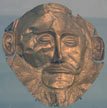 Funerary
gold death mask from Mycenae, also known as Schliemann's Agamemnon, found in
shaft Grave V of Grave Circle A at Mycenae. It is the most
expressive of those found in Grave Circle A. It is dated to the second half
on the 16th century BCE, four centuries prior to the Trojan War and could therefore not have belonged to the legendary king. The
impressive and majestic face on this gold mask reveals the unknown
artist's attempt at realistically portraying the features of a Mycenaean
sovereign. Funerary
gold death mask from Mycenae, also known as Schliemann's Agamemnon, found in
shaft Grave V of Grave Circle A at Mycenae. It is the most
expressive of those found in Grave Circle A. It is dated to the second half
on the 16th century BCE, four centuries prior to the Trojan War and could therefore not have belonged to the legendary king. The
impressive and majestic face on this gold mask reveals the unknown
artist's attempt at realistically portraying the features of a Mycenaean
sovereign. |
|

Elaborate bronze dagger with inlaid ornamentation to form a hunting
scene. Three heavily armed men are moving against an enormous lion
who has thrown one of their comrades to the ground. Two other lions are
fleeing, startled, and one of them is looking backwards, thus forming a
link with the main scene. The bodies of the men and lions are made of a
mixture of gold and silver and the shields are of niello (a compound
containing sulfur). The dagger was found in
Shaft Grave IV of Grave Circle A at Mycenae and is dated to the
16th century BCE. |
|
|
|
|
|
 Large
silver pin with a gold brooch in the form of a goddess attached to one
side. There are two floral
symbols superimposed above the head of the goddess, from which the rich
leaves and flowers that enclose her branch out. This wonderful picture
represents the deification of a protectress of the plant world, of Spring
and of the rebirth of life. From Shaft Grave III of Grave Circle A
at Mycenae. Dated to the 16th century BCE. Large
silver pin with a gold brooch in the form of a goddess attached to one
side. There are two floral
symbols superimposed above the head of the goddess, from which the rich
leaves and flowers that enclose her branch out. This wonderful picture
represents the deification of a protectress of the plant world, of Spring
and of the rebirth of life. From Shaft Grave III of Grave Circle A
at Mycenae. Dated to the 16th century BCE. |
|
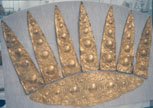
Gold rhomboid diadem with flat spear shaped pieces. It is not
known whether of how the diadem was supported on the head of the princess
to whom it belonged. The diadem is almost barbaric in form, with large elliptical,
pointed rhombuses above the main plate, both of which are decorated with
circles. It was found
in Shaft Grave III of Grave Circle A at Mycenae and is dated to the 16th century
BCE. |
|
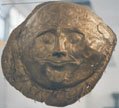 Gold
death mask from Shaft Grave IV of Grave Circle A at Mycenae portraying a
beardless man with closed eyes lacking any detail.
The mouth is outlined and the whole expression shows the peaceful
contentment of death. Dated to
the 16th century BCE. Gold
death mask from Shaft Grave IV of Grave Circle A at Mycenae portraying a
beardless man with closed eyes lacking any detail.
The mouth is outlined and the whole expression shows the peaceful
contentment of death. Dated to
the 16th century BCE.
|
|
|
|
|
|
 Silver
rhyton (a ritual vessel used to pour libations) in the shape of a bull's head.
The high horns are made of gold and its internal core would have been made
of wood. A gold rosette is attached to the forehead signifying that the
animal has been dressed for sacrifice. The whole craftsmanship and the
presence of a bull, which has parallels in Cretan works, leaves no doubt
that it was the work of Cretan smiths. This remarkable specimen
was found in Grave IV of Grave Circle A at Mycenae. Dated to the
16th century BCE. Silver
rhyton (a ritual vessel used to pour libations) in the shape of a bull's head.
The high horns are made of gold and its internal core would have been made
of wood. A gold rosette is attached to the forehead signifying that the
animal has been dressed for sacrifice. The whole craftsmanship and the
presence of a bull, which has parallels in Cretan works, leaves no doubt
that it was the work of Cretan smiths. This remarkable specimen
was found in Grave IV of Grave Circle A at Mycenae. Dated to the
16th century BCE. |
|
 Gold
pieces covering a child's body found in a tomb in Mycenae. The royal tombs on Mycenae
yielded so many gold objects that Homer's description of it as "the
city rich in gold" cannot be doubted. Gold
pieces covering a child's body found in a tomb in Mycenae. The royal tombs on Mycenae
yielded so many gold objects that Homer's description of it as "the
city rich in gold" cannot be doubted. |
|
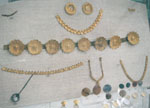
Assorted jewelry from the Mycenaean
shaft graves. |
|
|
|
|
|
|
 Gold
rhyton in the shape of a lion's head from Grave IV of Grave Circle A in Mycenae.
It is an exquisite example of Mycenaean embossed work.
Dated to the 16th century BCE. Gold
rhyton in the shape of a lion's head from Grave IV of Grave Circle A in Mycenae.
It is an exquisite example of Mycenaean embossed work.
Dated to the 16th century BCE.
|
|
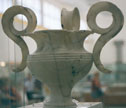 The
skilled hand of a Mycenaean craftsman at his best can be distinguished in
the most elegant of the Mycenaean alabaster vases. The curves of the body
and the handles, and the furrows which relieve them, can only be explained
in terms of the shape being copied from a bronze vessel. Found in Shaft Grave IV of Grave Circle A at
Mycenae. The
skilled hand of a Mycenaean craftsman at his best can be distinguished in
the most elegant of the Mycenaean alabaster vases. The curves of the body
and the handles, and the furrows which relieve them, can only be explained
in terms of the shape being copied from a bronze vessel. Found in Shaft Grave IV of Grave Circle A at
Mycenae.
|
|
 Ivory
figurine with two goddesses and the "divine child". Wearing
Creto-Mycenaean dress, they have their arms around each other and are
protecting the small child between them. A wonderful cloak is worn by both
goddesses, who perhaps are Demeter and Kore. The figurine was found in the
lower city of Mycenae and is dated to the 15th century BCE. Ivory
figurine with two goddesses and the "divine child". Wearing
Creto-Mycenaean dress, they have their arms around each other and are
protecting the small child between them. A wonderful cloak is worn by both
goddesses, who perhaps are Demeter and Kore. The figurine was found in the
lower city of Mycenae and is dated to the 15th century BCE. |
|
|
|
|
|
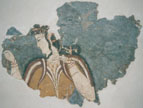
Fresco of a female figure discovered in a house just inside the west
wall of the acropolis at Mycenae. The female figure is depicted with the
upper body full frontal which gives her a certain divine appearance. The
white face is painted on a deep blue background and her gaze is firmly
fixed on the object that she is holding tightly in her right hand. She is
touching her throat with the long fingertips of her left hand. The
ornaments, with their light color, are emphasized by the colors of her
dress - brown, purple and white. The exquisite, very Greek face, is lost
in thought. The powerful design, the wide range of
colors and the expressiveness of the figure are unique in Mycenaean
art. Late 13th century BCE. |
|
 The
Poseidon from Cape Artemision. It is not only its height - 2.09
meters overall - that makes this a great work. The sculptor has captured
the movement of the god, poised
to hurl the trident that he holds in his right hand. The achievement of
the sculptor lies above all else in the freedom with which he has rendered
the legs apart, in chiastic balance with the open shoulders, and also in
the working of the head, the curls on the forehead and the hair tied
behind in a charming plait. It is an original work of a
great sculptor, possibly of Kalamis. It was raised from the sea, off
the cape of Artemision, in north Euboea. Dated to circa 460 BCE. The
Poseidon from Cape Artemision. It is not only its height - 2.09
meters overall - that makes this a great work. The sculptor has captured
the movement of the god, poised
to hurl the trident that he holds in his right hand. The achievement of
the sculptor lies above all else in the freedom with which he has rendered
the legs apart, in chiastic balance with the open shoulders, and also in
the working of the head, the curls on the forehead and the hair tied
behind in a charming plait. It is an original work of a
great sculptor, possibly of Kalamis. It was raised from the sea, off
the cape of Artemision, in north Euboea. Dated to circa 460 BCE. |
|
 The
Youth from Antikythera. Bronze statue of a young man, a god or a hero who held a
spherical object in his right hand. It could well be Paris, whose judgment
of the three goddesses and the apple of discord led to the Trojan War. It is
one of the most brilliant products of the Peloponnesian bronze sculpture,
perhaps the work of the famous sculptor Euphranor. It has the form of a
Classical statue, with that rhythm in the body that the Greeks were the
only people of the ancient world to study and achieve successfully. Newer
elements of the 4th century are the turning of the head towards the
relaxed right leg which is drawn back so that only the toes touch the
ground. The left arm, hanging free, is balanced by the looseness of the
right leg, while the left is tensed to match the right arm. It was found in the
area of an ancient Roman shipwreck off the island of Antikythera. Larger
than life, it is approximately 2 meters (7 feet) tall. Dated to
circa 340
BCE. The
Youth from Antikythera. Bronze statue of a young man, a god or a hero who held a
spherical object in his right hand. It could well be Paris, whose judgment
of the three goddesses and the apple of discord led to the Trojan War. It is
one of the most brilliant products of the Peloponnesian bronze sculpture,
perhaps the work of the famous sculptor Euphranor. It has the form of a
Classical statue, with that rhythm in the body that the Greeks were the
only people of the ancient world to study and achieve successfully. Newer
elements of the 4th century are the turning of the head towards the
relaxed right leg which is drawn back so that only the toes touch the
ground. The left arm, hanging free, is balanced by the looseness of the
right leg, while the left is tensed to match the right arm. It was found in the
area of an ancient Roman shipwreck off the island of Antikythera. Larger
than life, it is approximately 2 meters (7 feet) tall. Dated to
circa 340
BCE.
|
|
|
|
|
|
 Marble
Siren. In art, Sirens appeared first as birds with the heads of women, later
as women, sometimes winged, with bird legs. Sirens were placed as guards
on tombs of the sixth century BCE. Greek Sirens may have evolved
from Egypt. In Egyptian religion, the ba
is a portion of the soul which is generally represented as a bird with a
human head. Marble
Siren. In art, Sirens appeared first as birds with the heads of women, later
as women, sometimes winged, with bird legs. Sirens were placed as guards
on tombs of the sixth century BCE. Greek Sirens may have evolved
from Egypt. In Egyptian religion, the ba
is a portion of the soul which is generally represented as a bird with a
human head. |
|
 Marble
Siren. The Sirens, in Greek mythology,
were half bird and half woman sea nymphs who inhabited an island surrounded
by dangerous rocks. They sang so enchantingly that all who heard were
drawn near and shipwrecked. Marble
Siren. The Sirens, in Greek mythology,
were half bird and half woman sea nymphs who inhabited an island surrounded
by dangerous rocks. They sang so enchantingly that all who heard were
drawn near and shipwrecked. |
|
 Marble
Siren. The Sirens seem to have evolved from a primitive tale of the perils of early
exploration combined with an Oriental image of a bird-woman.
Anthropologists explain the Oriental image as a soul-bird - a
winged ghost that stole the living to share its fate. In that respect the
Sirens had affinities with the Harpies. Marble
Siren. The Sirens seem to have evolved from a primitive tale of the perils of early
exploration combined with an Oriental image of a bird-woman.
Anthropologists explain the Oriental image as a soul-bird - a
winged ghost that stole the living to share its fate. In that respect the
Sirens had affinities with the Harpies. |
|
|
|
|
|
 Crowning
device from a large funerary monument. The inventive imagination of the
workshops producing grave monuments in Athens during the 4th century BCE
can be seen in this large grave monument from Athens. There is a marble
fluted cauldron, with the upright necks and heads of griffons at
intervals, all reminiscent of the earlier bronze lebetes. Circa
340 BCE. Crowning
device from a large funerary monument. The inventive imagination of the
workshops producing grave monuments in Athens during the 4th century BCE
can be seen in this large grave monument from Athens. There is a marble
fluted cauldron, with the upright necks and heads of griffons at
intervals, all reminiscent of the earlier bronze lebetes. Circa
340 BCE. |
|
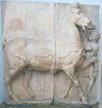 Large
funerary monument from Kolonos. A young Ethiopian groom is trying to
control a large horse, offering it some food which is not clearly defined.
The head of the horse is inspired, projecting as it does away from the
block, while the body remains attached to it. Above the horse's back there
are traces of a painted helmet belonging to the horseman who is not
portrayed. The intense, spasmodic movement of the groom, the whip in one
hand, the extended legs, the anxious face opposite the animal's head, the
contrast between the head of the dead skin of the panther and the open
eyes of the horse, and the whole muscular body of the latter reveal the
work of a bold artist fired with Greek genius. The whole shape of the
monument and the style of the carving in deep relief derive from the tradition
of the last Attic stelai (gravestones) before the law of 317 BCE,
thus this monument is placed during the first half of the 3rd century BCE
when grave monuments were no longer being erected in Attic cemeteries. Large
funerary monument from Kolonos. A young Ethiopian groom is trying to
control a large horse, offering it some food which is not clearly defined.
The head of the horse is inspired, projecting as it does away from the
block, while the body remains attached to it. Above the horse's back there
are traces of a painted helmet belonging to the horseman who is not
portrayed. The intense, spasmodic movement of the groom, the whip in one
hand, the extended legs, the anxious face opposite the animal's head, the
contrast between the head of the dead skin of the panther and the open
eyes of the horse, and the whole muscular body of the latter reveal the
work of a bold artist fired with Greek genius. The whole shape of the
monument and the style of the carving in deep relief derive from the tradition
of the last Attic stelai (gravestones) before the law of 317 BCE,
thus this monument is placed during the first half of the 3rd century BCE
when grave monuments were no longer being erected in Attic cemeteries. |
|
 Stele
portraying amazons fighting naked Greek men. Stele
portraying amazons fighting naked Greek men. |
|
|
|
|
|
 The
boy from Marathon is a bronze statue representing a youth, perhaps the god Hermes.
The dreamy expression and easy pose are characteristic of the works of Praxiteles,
the leading late Classical sculptor. It was found in the sea of the
Marathon bay and is dated to 325-300 BCE. The
boy from Marathon is a bronze statue representing a youth, perhaps the god Hermes.
The dreamy expression and easy pose are characteristic of the works of Praxiteles,
the leading late Classical sculptor. It was found in the sea of the
Marathon bay and is dated to 325-300 BCE. |
|
 Statuette
of a naked boy with a duck. He leans against a colonnette and clutches a
duck in his left hand. It was found near Lilaia at the foot of Mount
Parnassus. Third century BCE. Statuette
of a naked boy with a duck. He leans against a colonnette and clutches a
duck in his left hand. It was found near Lilaia at the foot of Mount
Parnassus. Third century BCE. |
|
 Statue
of the goddess Themis,
goddess of justice and mother of The
Fates and the Seasons, discovered in 1890 at Rhamnous, Attica. It has
survived together with its base where the inscription of the artist,
Chairestratos of Rhamnous, is incised along with the name of the
dedicator, Megakles, also of Rhamnous. Third century BCE. Statue
of the goddess Themis,
goddess of justice and mother of The
Fates and the Seasons, discovered in 1890 at Rhamnous, Attica. It has
survived together with its base where the inscription of the artist,
Chairestratos of Rhamnous, is incised along with the name of the
dedicator, Megakles, also of Rhamnous. Third century BCE. |
|
|
|
|
|
 The
philosopher of Antikythera. Portrait head of a bearded, elderly man,
perhaps a philosopher of the Hellenistic period. The striking head
combines personal characteristics with a formal ideal. It is a living
picture of an observant, skeptic philosopher of the Hellenistic period,
from the hand of some unknown sculptor. It has been suggested that it may
be a portrait, showing a psychological competence unknown in earlier
statues, of Bion the Borysthenite, a 3rd-century BCE philosopher who left
his mark on the age with his satirical "diatribes". It was found in an
ancient shipwreck off the island of Antikythera and is dated to 250-200 BCE. The
philosopher of Antikythera. Portrait head of a bearded, elderly man,
perhaps a philosopher of the Hellenistic period. The striking head
combines personal characteristics with a formal ideal. It is a living
picture of an observant, skeptic philosopher of the Hellenistic period,
from the hand of some unknown sculptor. It has been suggested that it may
be a portrait, showing a psychological competence unknown in earlier
statues, of Bion the Borysthenite, a 3rd-century BCE philosopher who left
his mark on the age with his satirical "diatribes". It was found in an
ancient shipwreck off the island of Antikythera and is dated to 250-200 BCE.
|
|
 The
Varvakeion Athena
dates from the Roman period (2nd century BCE). It is a
reduced copy of the famous gold and ivory cult statue
of Athena by Pheidias that
stood in the Parthenon for 1000 years. It takes its name from the
place in Athens where it was found. The goddess wears a peplos and a
helmet decorated with Pegasus and sphinxes. Her armor is decorated
with snakes and in her right hand she holds a small, winged victory, while
Errichthonius is curled up on her shield. The
Varvakeion Athena
dates from the Roman period (2nd century BCE). It is a
reduced copy of the famous gold and ivory cult statue
of Athena by Pheidias that
stood in the Parthenon for 1000 years. It takes its name from the
place in Athens where it was found. The goddess wears a peplos and a
helmet decorated with Pegasus and sphinxes. Her armor is decorated
with snakes and in her right hand she holds a small, winged victory, while
Errichthonius is curled up on her shield.
|
|
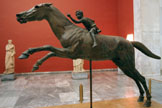
Horse and Jockey of Artemision. The horse is racing at full gallop
while the young jockey, dressed in a short tunic, is holding on tightly to
stay astride. He
probably held the reins in his left hand and a whip in the right. The work
is a fascinating example of the human passion which artists of the peak
period of the Hellenistic era succeeded in infusing into their most
inspired works. It was
found in pieces, in the area of a shipwreck off the cape Artemision, in
north Euboea. Dated to circa 140 BCE.
|
|
|
|
|
|
 This
large, marble statue of Poseidon stood in his temple on the distant island
of Melos. The posture shows a slight decline from the dynamic centrifugal emphasis
of earlier works from the first half of the 2nd-century BCE. The dolphin is
an ingenious device, forming a living support beside the right leg. The
vacant expression is typical of the age. The whole portrayal, probably by
a good, provincial Cycladic sculptor, was influenced by statues of gods or
leaders that stood in the great centers of Asia Minor. Circa 130
BCE. This
large, marble statue of Poseidon stood in his temple on the distant island
of Melos. The posture shows a slight decline from the dynamic centrifugal emphasis
of earlier works from the first half of the 2nd-century BCE. The dolphin is
an ingenious device, forming a living support beside the right leg. The
vacant expression is typical of the age. The whole portrayal, probably by
a good, provincial Cycladic sculptor, was influenced by statues of gods or
leaders that stood in the great centers of Asia Minor. Circa 130
BCE. |
|
 Statue
of Octavian Augustus. The first Roman emperor is represented riding a
horse and this is the only preserved life-size equestrian statue of
Augustus. He wears a heavy chiton and a mantle and he held the reins with
his left hand. The statue was recovered from the sea, in the area between
Euboea and the island of Aghios Eustratios. Dated to the end of the 1st
century BCE. Statue
of Octavian Augustus. The first Roman emperor is represented riding a
horse and this is the only preserved life-size equestrian statue of
Augustus. He wears a heavy chiton and a mantle and he held the reins with
his left hand. The statue was recovered from the sea, in the area between
Euboea and the island of Aghios Eustratios. Dated to the end of the 1st
century BCE. |
|
 Marble
group representing Aphrodite, the goat-footed Pan and Eros (height 1.30 meters).
Pan is trying to embrace the naked goddess who has removed her left sandal
with which she teasingly threatens to strike him. A little Eros flies
above the goddesses' shoulder and seizes hold of one of Pan's horns. It was found on Delos and dates to
circa 100 BCE. Marble
group representing Aphrodite, the goat-footed Pan and Eros (height 1.30 meters).
Pan is trying to embrace the naked goddess who has removed her left sandal
with which she teasingly threatens to strike him. A little Eros flies
above the goddesses' shoulder and seizes hold of one of Pan's horns. It was found on Delos and dates to
circa 100 BCE. |
|
|
|
|
|
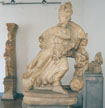 Athena
statue found at Epidauros. Athena
statue found at Epidauros. |
|
 Marble
statue
of goat-footed Pan. He is wearing an ox-skin. In his left hand he is holding
a syrinx (Pan-pipe). Marble
statue
of goat-footed Pan. He is wearing an ox-skin. In his left hand he is holding
a syrinx (Pan-pipe). |
|
|
|
|
|
|
|
© All pictures are Copyright 2000 Grisel Gonzalez and Jeff
Prosise
|